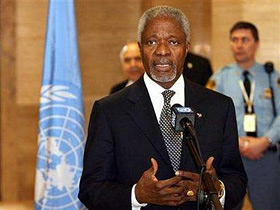 |
 |
 |
 News Around the Republic of Mexico | March 2006 News Around the Republic of Mexico | March 2006  
U.N.: Mexico Must Form Alliances with Other Latin Nations to Make Trade Headway in China
 Associated Press Associated Press


| | U.N. Secretary-General Kofi Annan is seen at the United Nations European headquarters in Geneva, Switzerland, February 27, 2006. Annan recommended on Tuesday a radical overhaul on the way the United Nations does business and suggested relocating U.N. translators out of New York as well as outsourcing other work. (Reuters/Dominic Favre) |
Mexico City Mexico must form strategic alliances with other Latin American nations if it wants to better penetrate China's dynamic commercial markets, whose rapid growth has generated a need for raw materials and food, a U.N. commission said this week.

Today, in the globalized world not even the big nations can live without alliances, and tackling the China issue, the Asia issue, requires strategic alliances in terms of trade, technology and investment, said Osvaldo Rosales, director of international trade for the U.N. Economic Commission for Latin America and the Caribbean, which was hosting a two-day conference on the subject in Mexico City.

Rosales said he envisioned such alliances between Mexico and Central American nations, which he said should take advantage of the benefits of the North American Free Trade Agreement, or NAFTA, and the free-trade agreement Central American nations have signed with the United States, known as CAFTA.

Mexico over the past few years has been exploring potential opportunities with China, which has experienced 9.7 percent annual growth in the past 25 years and in 2002 replaced Mexico as the No. 1 exporter to the United States.

Mexico could serve as a point of contact with China for Latin America, said commission members, who added that the Asian giant could also become a significant tourism market for Mexico in the next decade.

Those who are able to anticipate will receive a relevant income from a market that is just starting to grow, Rosales said.

Other potential markets for Mexico in China include energy, minerals, metals, wood and soy, he said.

Currently, Argentina and Brazil provide about 60 percent of China's soy imports, while Chile and Peru provide 40 percent of its copper imports. Still, Rosales said, Latin America represents a still-modest market, representing only 4 percent of China's imports all together. | 
 | |
 |



